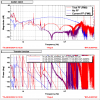Here is an investigation that might give us insight into the PRCL/CHARD/DARM coherences.
Today, we ran a PRCL injection for the feedforward where we injected directly into the PRCL loop. I took this injection time and looked at how the CHARD P and Y error signals changed, as well as their respective coherences to PRCL and DARM (figure). When injecting about 15x above ambient in PRCL from 10-100 Hz, there is a 2x increase in the CHARD P error signal and 4x increase in the CHARD Y error signal. The coherences of CHARD P and Y to PRCL increase as well, and the coherences of CHARD P and Y to DARM also increase. This injection allows us to measure a well-defined CHARD/PRCL transfer function. In the attached screenshot of this measurement, all the reference traces are from the injection time, and all the live traces are during a quiet time.
Meanwhile, I looked back at the last time we injected into CHARD P and Y for the noise budget, on June 20. In both cases, injecting close to 100x above ambient in CHARD P and Y did not change either the CHARD/PRCL coherence or PRCL/DARM coherence. There is some change in the PRCL error signal, but it is small. Again, in the attachments, reference traces are injection time and live traces are quiet time. CHARD P figure and CHARD Y figure.
I think that this is enough to say that the PRCL/DARM coupling is likely mostly through CHARD P and Y. This would also make sense with the failure of the PRCL feedforward today (79806). However, we may want to repeat the CHARD injections since there have been many IFO changes since June 20.
As a reminder, the previous work we did adding a PRCL offset did reduce the PRCL/CHARD coupling: read 76814 and the comments. We are currently not running with any PRCL offset.
I decided to compare the PRCL injection times back in March when I set the PRCL offset to reduce the coherence of DARM with LSC REFL RIN (76814, 76805). One conclusion of these tests was that a PRCL offset can reduce the REFL RIN/DARM coherence, but not necessarily improve the sensitivity. Also, the offset reduced the PRCL/CHARD Y coupling and increased the PRCL/CHARD P coupling.
A bruco shows that there is once again significant coherence with REFL RIN and DARM. I compared the PRCL injection time from yesterday with the PRCL injections with different offsets. The PRCL/ CHARD couplings have increased for both pitch and yaw: plot. I also included the coherences of CHARD to DARM for these times but then realized that data might actually be confusing to compare. However, the PRCL offset has an effect on the PRCL/CHARD coupling, so it could be one strategy to combat this coupling. Unfortunately, it has opposite effects for pitch and yaw.
There was a lot of work done to move the alignment of the PRC around in May; here are some alogs I found to remind myself of what happened: 77736, 77855, 77988. Seems like the goal was to reduce clipping/center on PR2. I wonder if this alignment shift caused the increase in the PRCL/CHARD coupling from March to now.
We should consider checking the PRCL and CHARD coupling while adjusting the PRC alignment. The yaw coupling is stronger, maybe because the beam is much further offcenter of PR2 in yaw than in pitch?
Overall, I think the benefit of this investigation would be a reduction of the noise in CHARD, which would help improve the sensitivity.
































